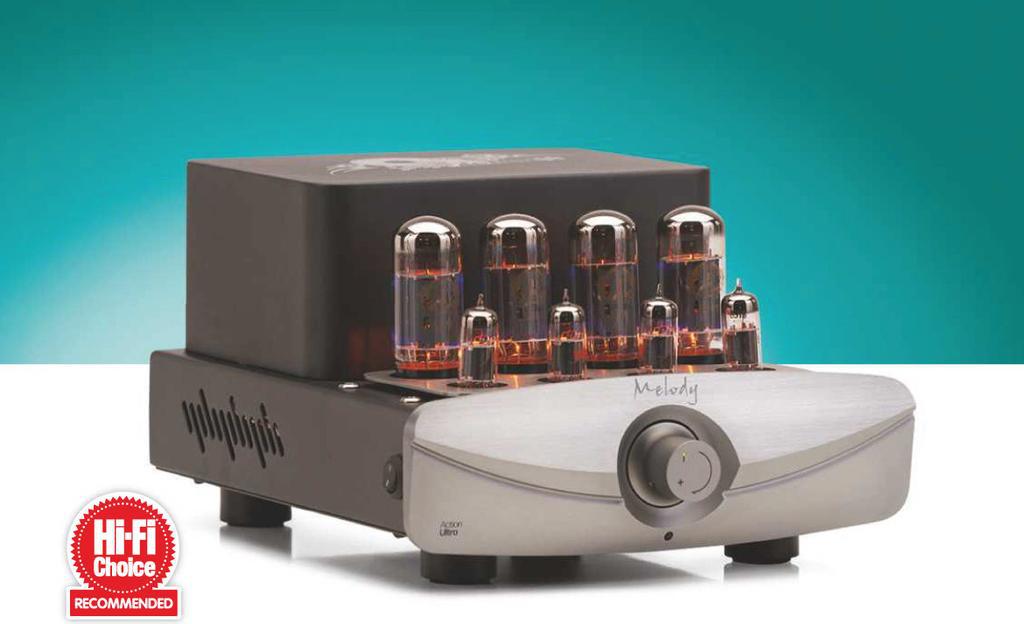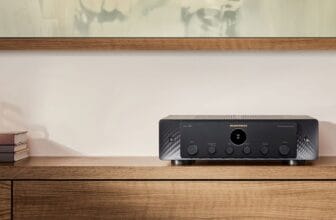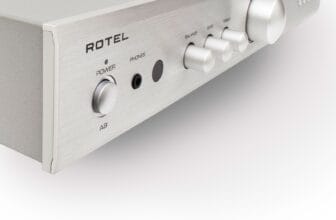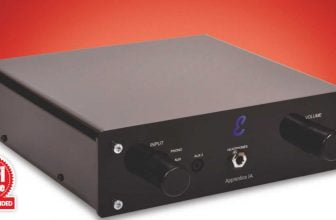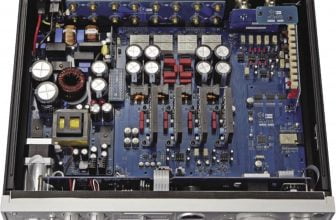Melody Action Ultra Review – Tubular belle
Melody might be a new name to the UK, but if this tube amp is anything to go by it will be sticking around predicts David Vivian. Read our Melody Action Ultra Review.
It would be easy to get the wrong idea about the Melody Action Ultra integrated tube amplifier. First, Melody. Who? If I tell you the company was founded in 1999 in Australia by Allen Wang to build nothing but valve amplification, my guess is if you live in the UK you’re none the wiser. Then there’s the Action Ultra itself. It’s almost ridiculously stylish for an entry-level valve amp and beautifully made. Yet printed on top of the black metal transformer cover is a very strange graphic depicting smoking tyre rubber and a chequered flag. Wasn’t expecting that. And it doesn’t take long to twig that on the front of the volume knob located in the middle of the facia, the ‘+’ and ‘–’ markings and the thin, curved line between them have been positioned to look like a winking smiley face emoji. Personally, I like that. There isn’t enough smiley face emoji action in hi-fi. But yes, back to those questions. Perhaps most obviously: is Melody a major or minor player? Encouragingly, the company is the embodiment of one’s man vision and passion for tubes, founder and current chief executive, Mr Wang. He’s also still the operation’s chief designer and, it’s pretty obvious, not unambitious. R&D and design remains in Australia, but with growing demand production has moved to China where a factory has its own transformer production line, vacuum processing plant, assembly line and high-end testing and measurement instruments.
Well-established in Australia and Asia, Melody sells an extensive range to suit all pockets and now has its sights on Europe. At the summit are the Everest 8688 Ultra High-End valve preamp and the Everest 212 Ultra High-End valve monoblocks – recommended, naturally, as an amplification double act, and yours for £… We can but dream.
Back down at sea level, the Action Ultra carries a more modest price tag and, despite the Hot Wheels overtones and smiley wink, is a deadly serious piece of kit, aiming to set performance benchmarks at its price and present a high-value proposition for audiophiles who want to sample thermionic valves without breaking the bank.
Apart from its sleek design and playful graphics, there’s nothing particularly unusual about the Action Ultra except, maybe, the amount of power it offers for its size and price. No sacred Watt single-ended triode design this, the Ultra’s four 5881 power tubes deliver a healthy 28W a side in a push-pull Class A/B configuration. Want even more mellifluous muscle? Melody also makes the identically priced Action Evo, which uses a quad of EL34 tubes and claims 40W per channel. Melody’s assessment of the classic EL34 is that it epitomises the ‘British sound’ with a dab of Marshall tonality thrown in. The Ultra’s 5881s, conversely, are described as having an ‘American sound’ with more refined highs and lows than the EL34. Oh, the fun to be had with tubes.
The music breathes and flows and sheds traces of edginess, grain and glare
In both cases, they’re joined by four RCA 6JT8 (6KT8) driver or gain tubes and all are proudly displayed, in two ranks, under a sturdy but removable metal tube guard. What you can’t see is the amp’s point-to-point internal wiring and, unlike Melody’s pricier offerings, bias is set automatically. Switch on and there’s a 30-second time delay before the Action Ultra is ready to perform, but as with all tube amps you don’t get its best game until everything is properly warmed up a good 30 minutes later.
On the rear are two line-level RCA inputs, an IEC mains socket and separate speaker taps for 4 and 8ohm speaker loads. What controls there are reside on the flank panels, power on/off on the right and an identical switch to toggle between the two inputs on the left. Oh, and there’s a weighty, all-metal remote, almost absurdly lightly burdened but rather gorgeous all the same.
Sound quality
Sometimes it’s a good idea to take a ‘sorbet break’ to cleanse the auditory palate before getting stuck into the next speaker, amplifier or whatever. I don’t want to this time. On the kit rack prior to the Melody is Electrocompaniet’s EC 80D (HFC 473), a solid-state integrated with a distinctly ‘tube-like’ tonal quality to complement the grip and control of a well-engineered transistor design. In fact, I make a point of playing several tracks with the EC 80D in situ before swapping swiftly over to the Action Ultra and the differences are far from night and day.
Perhaps predictably, and in broad terms, the EC 80D sounds a little more explicit, tautly timed and robust, the Action Ultra marginally more expansive and romantic, and this without seeming in any way limp-wristed or ‘loose’. As the late Tim de Paravicini (EAR Yoshino) once told me: inherent ‘valve sound’ is a myth. Solid state can be made to sound like tubes and vice versa. It all depends on the circuit topology.
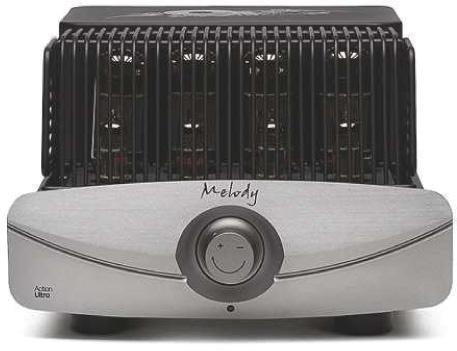
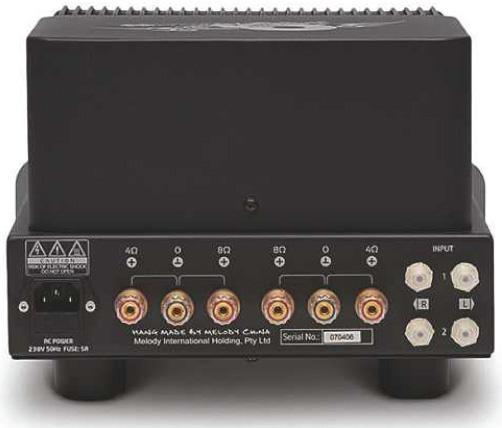
But even at this modest price there does seem to be a crucial difference, mostly to do with the midrange, and it can be summed up in one word: ‘sexier’. The music breathes and flows and sheds, however vestigial, traces of edginess, grain and glare – particularly apparent when dealing with digital sources. Everything somehow seems less ‘electronic’. The human voice sounds more human. It’s an effect that might even only register at a subliminal level, but it can elicit an internal sigh as you relax into the music. Not every low-priced valve amp possesses the ‘sigh factor’ – arguably the best reason for taking the tube – but this one does.
Melody’s range suits all pockets and the company now has its sights on Europe
Listener fatigue? There isn’t any. Charm? By the lorry load. All right, admittedly pricier valve amps, especially low-powered SETs, will have a rosier glow, greater transparency and more finely nuanced microdynamics, but the Action Ultra’s generous push-pull power means it can drive a wider variety of speakers to decent levels in most rooms and it proves a magnificent match with my resident Audiovector QR5 floorstander (HFC 468).
Prince’s Welcome 2 America is presented as a model of pristine definition and tonal warmth, propulsive funk and lightly finessed detail, and the Melody balances the diverse elements with an assurance and temporal tenacity that’s immensely engaging. On a larger stage, Grieg’s Peer Gynt Suites are treated to a generous soundstage with a fine sense of depth in which the massed strings have a particularly natural and unforced quality, as well as convincing body and texture.
Conclusion
As a cost-effective introduction to valve amplification, it’s hard to see how the Action Ultra can do any better. It has plenty of real-world, speaker-driving power and sound quality with the requisite midrange magic bolstered by excellent high-frequency refinement and a well-extended and controlled bass. In addition to which it’s stylish, well made and a joy to use. In short, it hits all the right notes
DETAILS
PRODUCT
Melody Action Ultra
ORIGIN
Australia/China
TYPE
Integrated amplifier
WEIGHT
15.5kg
DIMENSIONS
(WxHxD) 300 x 200 x 410mm
FEATURES
• Quoted output power: 2x 28W
• 4 and 8ohm speaker taps
• 4x Melody 5881 valves
• 4x Melody 6JT8 (6KT8) valves
DISTRIBUTOR
VAL HiFi
TELEPHONE
0333 5772005
WEBSITE
HOW IT COMPARES
We’d recommend thumbing through Icon Audio and PrimaLuna’s extensive ranges. But perhaps the most obvious place to start is with the Action Ultra’s immediate siblings. If you fancy you’ll prefer the sound of EL34 valves, Melody offers the Action Classic, which uses a brace and 11W per channel in pure Class A. Perhaps best for a small room. With a larger space to fill, the Action Evo might be a better bet than the Ultra as it has four EL34s and a claimed 40W a side. Fighting the corner for solid state, we can think of nothing better than Hegel’s H95 (HFC 468).
